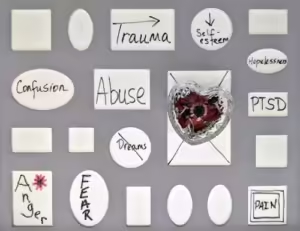
Post-Traumatic Stress Disorder (PTSD) can have a profound impact on individuals, altering their lives in significant ways. It’s a condition that develops after a person has been exposed to traumatic events such as accidents, natural disasters, combat, or any situation that induces intense fear, helplessness, or horror. Over the years, research has given us greater insight into how PTSD develops, leading to more refined treatment methods. This guide will explore the latest scientific-backed treatments for PTSD and provide valuable information for anyone looking to understand the condition better.
1. What is PTSD?
Post-Traumatic Stress Disorder (PTSD) is a mental health condition triggered by experiencing or witnessing a traumatic event. People suffering from PTSD may experience a variety of symptoms, including flashbacks, nightmares, severe anxiety, and uncontrollable thoughts about the event. These symptoms can interfere with daily life, making it hard for people to function normally. According to the American Psychiatric Association, PTSD affects around 3.5% of adults in the United States annually, and the numbers are even higher for veterans and individuals in high-stress professions.
2. The Evolution of PTSD Treatments
Treatment for PTSD has come a long way since its early identification. In the past, trauma survivors were often left untreated, but today, science-backed therapies have proven to be highly effective in helping individuals manage and recover from PTSD. As our understanding of PTSD has expanded, treatment options have diversified, making recovery more accessible.
3. Cognitive Behavioral Therapy (CBT)
Cognitive Behavioral Therapy (CBT) remains one of the most well-researched and effective treatments for PTSD. This therapy focuses on changing negative thought patterns that contribute to the disorder. The core concept behind CBT is that our thoughts, feelings, and behaviours are interconnected. By identifying and challenging distorted thinking patterns, individuals can better manage their symptoms.
Within CBT, there are several subtypes specifically designed for PTSD treatment:
- Cognitive Processing Therapy (CPT): This helps patients learn how to reframe negative thoughts about the trauma.
- Prolonged Exposure (PE): A type of therapy where individuals are gradually exposed to trauma-related memories and situations they avoid, helping to reduce their fear over time.
4. Eye Movement Desensitization and Reprocessing (EMDR)
Another cutting-edge therapy for PTSD is Eye Movement Desensitization and Reprocessing (EMDR). This method uses rapid eye movements to help the brain process and integrate traumatic memories. It’s believed that EMDR helps “unlock” traumatic memories and allows the brain to reprocess them more healthily. Studies show that EMDR is particularly effective in reducing the symptoms of PTSD in a relatively short time compared to traditional therapies.
5. Medications for PTSD
Medications are often prescribed to help individuals manage the symptoms of PTSD. These are generally used alongside psychotherapy and are not considered a cure on their own. The most common medications prescribed are Selective Serotonin Reuptake Inhibitors (SSRIs) such as Sertraline and Paroxetine, which are approved by the U.S. Food and Drug Administration (FDA) specifically for PTSD treatment.
These medications work by regulating serotonin levels in the brain, helping to alleviate symptoms like anxiety, depression, and hyperarousal. It’s important to note, however, that medications may not work for everyone, and they come with potential side effects. Therefore, it’s crucial to work closely with a healthcare provider to find the best treatment plan.
6. Mindfulness and PTSD
In recent years, mindfulness-based therapies have gained recognition as an effective way to manage PTSD symptoms. Mindfulness focuses on being present and fully engaged at the moment, helping individuals to avoid becoming overwhelmed by traumatic memories. Techniques like Mindfulness-Based Stress Reduction (MBSR) and Mindfulness-Based Cognitive Therapy (MBCT) have been shown to reduce PTSD symptoms by fostering greater emotional regulation and reducing stress levels.
7. Virtual Reality Exposure Therapy (VRET)
Virtual Reality Exposure Therapy (VRET) is an innovative approach that combines technology with traditional exposure therapy. By immersing patients in a controlled virtual environment, they can confront trauma-related situations in a safe, simulated setting. This technique is especially beneficial for veterans or those who have experienced combat-related trauma. Studies indicate that VRET can significantly reduce PTSD symptoms over time.
8. Neurofeedback for PTSD
Neurofeedback is an emerging treatment that involves monitoring brain waves and providing real-time feedback to patients, helping them regulate their brain activity. The goal of neurofeedback is to train the brain to function more optimally by reducing the hyperactivity often associated with PTSD. Although still in the early stages of research, many people have found neurofeedback to be a valuable addition to their treatment plan. For more: https://www.apa.org/ptsd-guideline/treatments
9. Group Therapy and Support Groups
Sometimes, the best way to heal from trauma is to share your experiences with others who understand. Group therapy offers individuals the opportunity to connect with people who have faced similar challenges. Support groups provide a sense of community and reduce feelings of isolation, which are common among PTSD sufferers. Being part of a group can be empowering and offer long-term support during the recovery process.
10. Holistic and Complementary Approaches
In addition to conventional therapies, many individuals with PTSD are turning to holistic treatments like yoga, acupuncture, and meditation. These complementary therapies focus on the mind-body connection and aim to promote overall well-being. Yoga and meditation, in particular, have been shown to reduce stress and anxiety, while acupuncture may help regulate the nervous system.
Conclusion
PTSD is a complex condition, but thanks to modern scientific advancements, effective treatments are more accessible than ever. From Cognitive Behavioral Therapy and EMDR to medications and mindfulness-based therapies, there are a variety of approaches available that can help individuals reclaim their lives after trauma. While no single treatment works for everyone, finding the right combination of therapies is key to recovery. If you or someone you know is struggling with PTSD, consulting with a mental health professional is the first step toward healing.
Remember, recovery is possible, and with the right support, individuals can overcome PTSD and lead fulfilling lives.
Frequently Asked Questions (FAQs)
Q1: What is the most effective treatment for PTSD?
There isn’t a one-size-fits-all approach to PTSD treatment, but Cognitive Behavioral Therapy (CBT), particularly Cognitive Processing Therapy (CPT) and Prolonged Exposure (PE), have proven to be highly effective. EMDR and medications like SSRIs also offer significant relief for many people.
Q2: How long does PTSD treatment take?
The duration of treatment varies depending on the severity of symptoms and the type of therapy used. Some individuals may experience improvement within 3 to 6 months, while others may require ongoing treatment for a year or more.
Q3: Can PTSD be cured completely?
While PTSD can be effectively managed, there’s no definitive “cure.” With the right combination of therapies, many individuals experience a significant reduction in symptoms and regain a sense of normalcy.
Q4: Are medications necessary for treating PTSD?
Not always. Medications like SSRIs can help manage symptoms, but they are usually used alongside therapies like CBT or EMDR. Some individuals manage PTSD without medications, focusing on psychotherapy, mindfulness, and other non-medication-based treatments.
Q5: What is EMDR, and how does it work for PTSD?
EMDR (Eye Movement Desensitization and Reprocessing) is a therapy that helps the brain reprocess traumatic memories by using rapid eye movements. It’s thought to facilitate the integration of these memories in a way that reduces emotional distress.
Q6: Is group therapy helpful for PTSD?
Yes, group therapy can be very beneficial. It provides a supportive environment where individuals can share their experiences, learn from others, and feel less isolated in their trauma.
Q7: Can mindfulness help with PTSD?
Absolutely. Mindfulness-based therapies like MBSR and MBCT have shown promise in helping individuals regulate their emotions and reduce PTSD symptoms by promoting awareness and acceptance of the present moment.
Q8: Is PTSD only a condition that affects veterans?
No. While veterans and those in combat-related roles are more susceptible to PTSD, anyone who has experienced or witnessed a traumatic event can develop the condition.
Q9: What is Virtual Reality Exposure Therapy (VRET)?
VRET is a form of exposure therapy that uses virtual reality to immerse patients in a simulated environment related to their trauma. This allows individuals to confront their trauma in a safe and controlled setting, reducing the intensity of their emotional reactions over time.
Q10: How do holistic approaches like yoga and acupuncture help with PTSD?
Holistic treatments such as yoga and acupuncture focus on the mind-body connection, helping to reduce stress, improve emotional regulation, and promote overall well-being. These therapies are often used alongside conventional treatments to enhance recovery.







Thank you for your articles. They are very helpful to me. May I ask you a question?
Thanks.
Thank you for writing this article. I appreciate the subject too.
Thanks for appreciating.